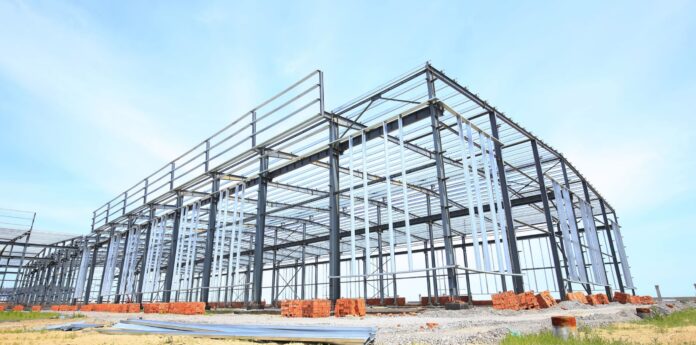The construction industry is continuously evolving, embracing new technologies and materials to address the needs of modern infrastructure. Among these advancements, steel has emerged as a predominant force, and with it, the growth in prominence of steel builders is redefining construction in both industrial and rural areas. This transition to steel as a primary building material is reshaping the landscape and setting new standards for efficiency, durability, and versatility.
The Advent of Steel in Construction
Steel has long been associated with its robust characteristics, offering a high strength-to-weight ratio that is unrivalled by traditional building materials. This feature alone makes it nominally superior for large-scale constructions, where reliability and longevity are paramount. For industrial buildings, in particular, steel answers the clarion call for such prerequisites.
Industrial spaces require a framework that can withstand a variety of stress factors, including heavy machinery operation, vast open spaces free of supportive columns, and the need for custom configurations. Steel builders have become adept at navigating these challenges, providing solutions that facilitate operational efficiency and adaptability.
Steel Builders: Catalysts for Change
The dynamism witnessed in steel construction is not solely limited to industrial realms. It permeates rural areas as well, bringing with it a set of tailored benefits. The expertise of steel builders extends to rural buildings, from agricultural sheds to storage facilities. The properties of steel stand up to the environmental demands of the countryside, ensuring resilience against extreme weather conditions and pests, which are common woes in rural construction.
Rural landscapes are often characterised by the need for bespoke construction solutions. Irrespective of the intended use, be it for storage, housing livestock, or as workshops, the flexibility offered by steel allows for custom-built structures that can expand or transform as requirements shift over time. This adaptive approach resonates with the needs of rural industries where the utilisation of space can fluctuate with seasonal demands.
Efficiency and Environmental Considerations
Another aspect that reinforces the adoption of steel in construction is efficiency. Steel builders leverage prefabricated components that streamline the building process, substantially reducing both construction time and waste. Such efficiency is not just beneficial from a practical standpoint but also adheres to environmentally friendly practices.
Steel’s recyclability is a commendable feature that aligns with contemporary environmental pursuits. Unlike many traditional materials, steel maintains its properties after recycling, making it a sustainable option for conscientious developers. The environmental footprint of construction projects, thereby, witnesses a significant diminution.
Technical Innovations in Steel Construction
Emphasising the technical edge, steel builders employ innovative design software and engineering approaches that align with the latest standards and regulations. This technical finesse facilitates the creation of structures that are both safe and aesthetically pleasing.
Advances in engineering software empower designers to envision and execute complex structures that may have once been deemed impractical or too costly. These tools allow for precise calculation and modelling, bringing a new dimension of customisation to both industrial and rural projects.
Cost-Effectiveness and Durability
Steel’s ascension in the construction hierarchy is also attributed to its cost-effectiveness. With the capability for mass production of components and shorter construction timelines, steel presents an economically viable solution for a multitude of construction needs. Financial advantages aside, the durability of steel structures speaks volumes; resistance to fire, termites, and decay stands out as a significant contrast to wood or concrete alternatives.
Steel builders recognise the importance of delivering projects that remain robust over time. This trait is particularly critical in industrial settings, where interruptions due to structural failures can lead to considerable financial loss. Rural constructions, too, benefit from such permanence given the importance of protecting assets from the harsh elements.
Challenges and Adaptations in Construction
Despite steel’s many positive attributes, its incorporation into construction is not without challenges. Steel builders must account for factors such as thermal expansion and conductivity. However, through the use of advanced insulation materials and architectural ingenuity, these challenges are adeptly met, allowing steel to maintain its position as a leader in the building materials sector.
In rural environments, challenges also arise surrounding accessibility and transportation of materials. Nevertheless, the pre-engineered nature of steel components significantly simplifies this aspect by reducing the number of deliveries and the complexity of on-site work required.
The Upward Trajectory of Steel Builders
The professional acumen of today’s steel builders has elevated them to a central role in modern construction. Their ability to offer tailored, cost-effective, and future-proof solutions for complex industrial and rural spaces makes them invaluable players in the construction industry’s ongoing evolution.
Steel builders are increasingly becoming intrinsic to the development of sustainable, long-lasting, and efficient structures around the globe. Be it for industrial buildings with their vast, open-plan designs or rural buildings suited to the diverse needs of the countryside, the case for steel in construction becomes ever more persuasive.
Conclusion: The Future of Construction with Steel
The advancement of steel builders in the construction industry reflects a broader trend towards innovation and sustainability. As we advance, the role of steel in both industrial and rural construction is set to expand further, driven by technological advancements and the demand for smarter, greener building practices. The rise of steel builders is not just a trend, but a testament to the material’s intrinsic value in today’s construction landscape, promising a foundation of strength, versatility, and efficiency for the future.
